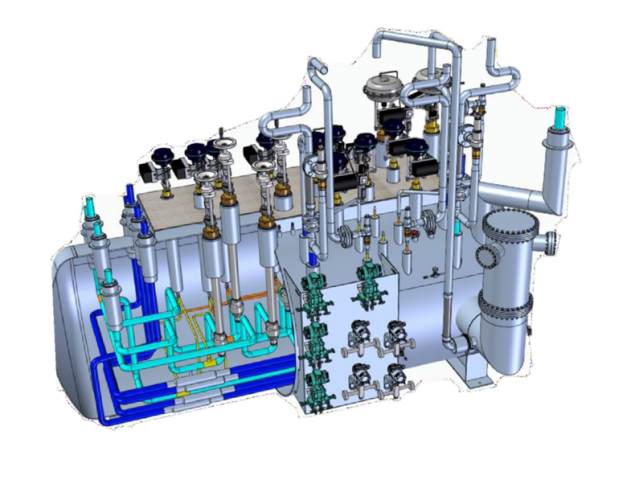 Hydrogen is the most abundant chemical element in the universe and the most important feedstock for life. In Greek, the word “hydrogen” is composed of the terms “hydro” and “genes,” which means water generator. In 1766, the English chemist Henry Cavendish distinguished hydrogen from other flammable gases and identified its properties, but the name hydrogen was given by Antoine-Laurent Lavoisier in 1781. Hydrogen was commonly featured in the design of gas balloons in the 18th century, and then in the 20th century, substantial exploitation of hydrogen propellants in space propulsion systems began.
Hydrogen is the most abundant chemical element in the universe and the most important feedstock for life. In Greek, the word “hydrogen” is composed of the terms “hydro” and “genes,” which means water generator. In 1766, the English chemist Henry Cavendish distinguished hydrogen from other flammable gases and identified its properties, but the name hydrogen was given by Antoine-Laurent Lavoisier in 1781. Hydrogen was commonly featured in the design of gas balloons in the 18th century, and then in the 20th century, substantial exploitation of hydrogen propellants in space propulsion systems began.
Hydrogen is not in the free state. It is produced by separating it from the other elements which it is combined with, through the processes that consume energy, called electrolysis and reforming. Unlike carbon-based fuels, hydrogen does not generate harmful waste, as it is fuel that burns cleanly and efficiently, creating an energy cycle that is renewable to the environment.
Hydrogen is used on a daily basis as a liquid gas by many industries for the production of chemicals and electronics, as well as space shuttles, fuel and space capsule propulsion. This work condition requires sophisticated cryogenic systems and insulation techniques.
The use of liquid hydrogen is present in cryogenic systems in part of projects of major value for science and development, such as ESS, ISRO, DLR and ESA of Sweden, India, Germany and Europe, respectively. These institutes are recognized worldwide for their scientific research on planetary exploration, space travel and scientific breakthroughs related to materials, health and the environment.
In cryogenic engineering, the quality of design and manufacture makes an extreme difference in the effectiveness and performance of the equipment throughout its lifetime. These constructions are based on the use of vacuum technology, which maintains the permanence of hydrogen in its liquid state and at the required temperature, according to the application need.
The European Spallation Source (ESS) is a research facility that aims to be a leader within materials research by using neutrons. For transforming fast into slower neutrons for research, ESS will use subcooled liquid hydrogen as a coolant, and Demaco, which has three decades of experience in the cryogenics and hydrogen industries, is responsible for delivering part of the equipment that will make this project possible.
Demaco is developing the design and will manufacture, test and install a cryogenic valve box, several single transfer lines and required piping that constitutes part of the ESS cryogenic system. The valve box receives hydrogen from the main supply line and distributes it into four supply lines, leading towards the cryogenic moderators. Likewise, the valve box receives the hydrogen return lines, which merge into the main return line.
The illustration presents the 3D model of the valve box for the so-called cryogenic distribution and ortho-para measurement system (OPMS) at ESS. Besides the liquid hydrogen distribution system, the valve box contains a dedicated part used by ESS to measure the ortho-para fraction of the hydrogen returning from the moderators.
Valve boxes are dedicated devices of immense importance in a cryogenic system. The challenges in the execution of the distribution box project are related to the lack of space to accommodate a considerable number of instruments: temperature sensors, flow meters, cryogenic valves and pressure measurement devices, among others. Furthermore, the design solution respects not only ATEX regulations but also extra safety measures, due to the hard pressure requirements combined with a potentially explosive atmosphere.
The design of the transfer lines is not a typical design for single transfer lines, but a complex design. In the ESS project, the single transfer lines have a shared vacuum, one of ESS’ requirements to optimize safety. Due to the pressure drop combined with the use of hydrogen requirements in the design of the transfer lines, special pressure safety valves, special bellows, flexible components, and special Demaco Johnston couplings were selected, in order to keep hydrogen contained. This setup guarantees the reliability of the device. The connection in the monolith vessel (application) is a critical area. Due to the presence of ionizing radiation levels and external vacuum to which the equipment will be exposed, additional analyses have to be performed to assure the equipment’s integrity. Moreover, 100% X-ray is applied, not only to the process piping but also to the vacuum jacket (normally this would only be 10%), guaranteeing quality from the beginning to the end of the hydrogen transfer process.
This unique project is possible due to the cooperation between ESS and Demaco cryogenic teams, and Demaco’s professional knowledge that is capable of offering an integral approach from the measurement, design, manufacturing and installation of reliable cryogenic equipment, allowing ESS to increase the excellence of its scientific research. “It’s all about cryogenius.” www.demaco.nl ■
[Source: Cold Facts Vol 37 No 6]


